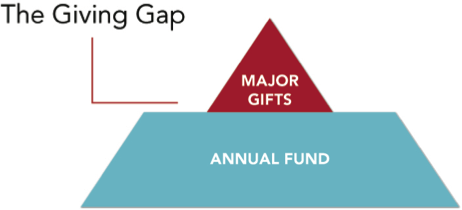Pursuant has the privilege of working with hundreds of nonprofit organizations every year. This affords us the ability to see patterns across the sector. Certain verticals (e.g. health care and universities) tend to be strong in major donor development and capital campaign work, yet struggle in direct response. Other verticals (e.g. faith-based, human services) are stronger in direct response but lack the level of major donor strength we see other places.
However, one of the few universal patterns we see across the nonprofit landscape—in every single vertical—in a universal absence of a strong mid-level donor development program. Results are mediocre at best. These donor pyramids look more like a sombrero than a triangle!
Our analysis has shown, generally speaking, that for every 11,000 low-to-mid-level donors and nondonors on file, the potential exists to generate in excess of $1 million in immediate commitments, and to realize another $14 million in longer term giving.
That isn’t chump change. And if those figures aren’t compelling enough consider the impact a vigorous mid-level program will have downstream on an organization’s major donor efforts. A healthy mid-level program is to an organization what a AAA club is to a major league baseball team: a feeder system.
So what happened? Why are such resources going virtually untapped? More importantly, what does it take to cost-effectively reach these donors-at-the-margin and engage them in a way where they are ready and willing to make a substantial commitment? This week on the blog we are going to identify challenges and solutions to mid-level cultivation, and then close with “an offer you can’t refuse” to help take your mid-level cultivation efforts to a whole new level.
What Went Wrong??
The fundamental theories and practices surrounding direct response programs and major donor development have been in place for decades. We know how they work. Certainly times have changed, giving us better ways to drive better results from both ends of the pyramid. But the basic structures for development are well established.
But potential mid-level donors are somewhat out of reach. They require more trust than can be quickly cultivated through direct response mechanisms, yet don’t provide sufficient support to be part of a major gift officer’s portfolio. Some use the efficiency of the telephone to keep costs down—and that is certainly better than a form or personalized letter. But calls are inevitably made in response to a mid-level gift and miss literally hundreds of low-level donors and non-donors who would give more if their relationship with and trust in your organization was at a deeper level.
Pursuant’s observation is that mid-level programs suffer for six reasons:
• Lack of strategy: For the reasons cited above, organizations don’t know how to approach potential mid-level donors in a cost-effective manner that compels them to respond.
• Lack of information: Organizations don’t know who, across the myriad of low-level donors and nondonors, are likely to respond to a request for support, yet they can’t afford to meet with everyone. Wealth overlays have helped some, but still fall short in providing information about the specific mindset and interest level of each donor and nondonor on file.
• Lack of a compelling story: Organizations don’t know how to present their need for support in a way that engages a mid-level donor and compels them to take action.
• Lack of trust: Trust is central to growth in support. But organizations struggle to know how to create the level of trust and relationship necessary to encourage mid-level commitments.
• Lack of rigor: Minimizing costs requires a rigor and commitment most organizations and major or mid-level gift officers don’t have. We have seen officers meet with as few as 50 people a year in an environment where closer to 250 face to face visits per year are necessary to operate cost effectively.
• Lack of systems: Organizations don’t have the systems in place to a) hold gift officers accountable for results, and b) ensure ongoing communication systems are in place that keep mid-level donors sufficiently engaged and enthusiastic.
Given the above issues, it is no wonder a gap exists in the middle of almost all nonprofit donor pyramids, and will continue to until we can find a way to address them.
Want more insights on mid-level? Check out our recent webinar series, the Mid-Level Master Sessions.



